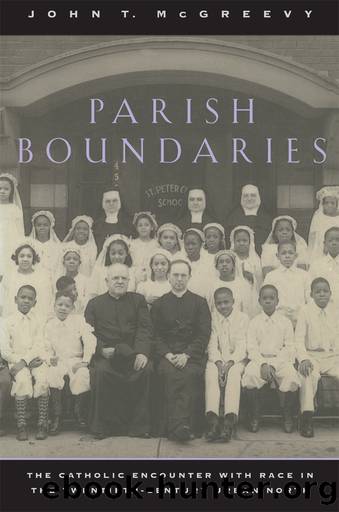Parish Boundaries by John T. McGreevy

Author:John T. McGreevy [McGreevy, John T.]
Language: eng
Format: epub
Publisher: The University of Chicago Press
Published: 1996-06-15T00:00:00+00:00
Father James Groppi leading freedom songs at a 1965 Milwaukee public school boycott. State Historical Society of Wisconsin, WHi (Ã3) 37641.
On the opening day of the boycott, twelve Catholic priests and twenty-five nuns were highly visible in the operation of the freedom schools. Instead of using the St. Boniface school building, Father Groppi led a group of 500 African-American students to a neighboring Baptist church for a two-hour lesson on African-American history and civil rights songs.83 The next day, the two Milwaukee dailies carried an advertisement entitled âAn Open Letter To Our People,â paid for by the inner-city priests. By not using parochial facilities, the priests argued, âour church fails to give its full Christian witness here. On the other hand, should we disobey the bishop we feel that at this time in our Church many would not be able to understand our actions, and so would suffer some spiritual harm because they are not yet ready to receive the full impact of Vatican II.â Father Bleidorn began his next Sundayâs homily by reading from James, 2:12â17: âMy brothers, what good is there in anyoneâs professing his faith if he does nothing in practice?â84
Local reaction to these events was mixed. To the dismay of some parents, a group of Marquette High School students already participating in a discussion group focusing on racial issues applauded Groppiâs actions. (In the fall of 1964, the group had resolved that âDiscussion . . . was fruitless if divorced from actual experience.â)85 Many of the letters to Groppi and his colleagues also expressed support, with a typical comment being one womanâs declaration that âI have felt for some years that the church has not been as active as it should be in the field of civil rights.â She added that âSixteen years of parochial school education taught me that Christ was always on the side of the underdog and gave not a second thought to civil disobedience or its consequences.â Archbishop Cousins refused to discipline the priests upon his return from Rome, even after Groppi chained himself to a school construction site to protest segregated education. While terming Groppiâs behavior a âlittle immature,â Cousins also told a reporter that âHe [Groppi] has a lot of guts and is doing things maybe others of us donât have the courage to do.â86
Groppiâs opponents were no less impassioned. Letters of opposition poured into the chancery office and filled the editorial columns of local papers. A group of thirteen âCatholic Laymen, workers in an industrial complex,â mailed a painstakingly composed missive to the archbishop, Groppi, and Bleidorn. âIt is regrettable,â the letter began, âthat Catholic clergy should encourage contempt for the law by urging children and young people to aid and abet this school boycott. During their formative years, children should be taught discipline in accord with the fourth commandment. Rebellion is a primary tenet of communism.â Other letter writers denied that they were prejudiced, while attacking the tactics of the protesters. â[I]f our priests and nuns must demonstrate,â
Download
This site does not store any files on its server. We only index and link to content provided by other sites. Please contact the content providers to delete copyright contents if any and email us, we'll remove relevant links or contents immediately.
The Writings of Henry Barrow, 1590-91 by Leland H. Carlson(116)
Jesus Wars: How Four Patriarchs, Three Queens, and Two Emperors Decided What Christians Would Believe for the Next 1,500 Years by John Philip Jenkins(115)
A History of Liturgical Books by Palazzo Eric(114)
The Virgin by Ashe Geoffrey(113)
Dark mysteries of the vatican by H. Paul Jeffers(106)
The Decline of Established Christianity in the Western World by Peterson Paul Silas(106)
The Rhetorical Leadership of Fulton J. Sheen, Norman Vincent Peale, and Billy Graham in the Age of Extremes by Sherwood Timothy H.;(101)
Church, State and Dynasty in Renaissance Poland: The Career of Cardinal Fryderyk Jagiellon (1468-1503) by Natalia Nowakowska(100)
The Pietist Impulse in Christianity by Christian T. Collins Winn(96)
Crusaders, Cathars and the Holy Places by Hamilton Bernard;(94)
In Discordance with the Scriptures: American Protestant Battles Over Translating the Bible (Religion in America) by Peter J. Thuesen(89)
Intimacy and Exclusion by Dagmar Herzog(87)
The Origins of Southern Evangelicalism by Little Thomas J.;(86)
Holy Matter by Sara Ritchey(82)
Parish Boundaries by John T. McGreevy(77)
Lonely Mystic : A New Portrait of Henri J. M. Nouwen by Michael Ford(74)
Rufinus of Aquileia: History of the Church by Rufus of Aquileia (Author) & Philip R. Amidon (Translator)(69)
Catholic Gentry in English Society: The Throckmortons of Coughton from Reformation to Emancipation by Peter Marshall Geoffrey Scott (eds.)(67)
The Eastern Churches Trilogy: The Orthodox Eastern Church by Adrian Fortescue(63)
